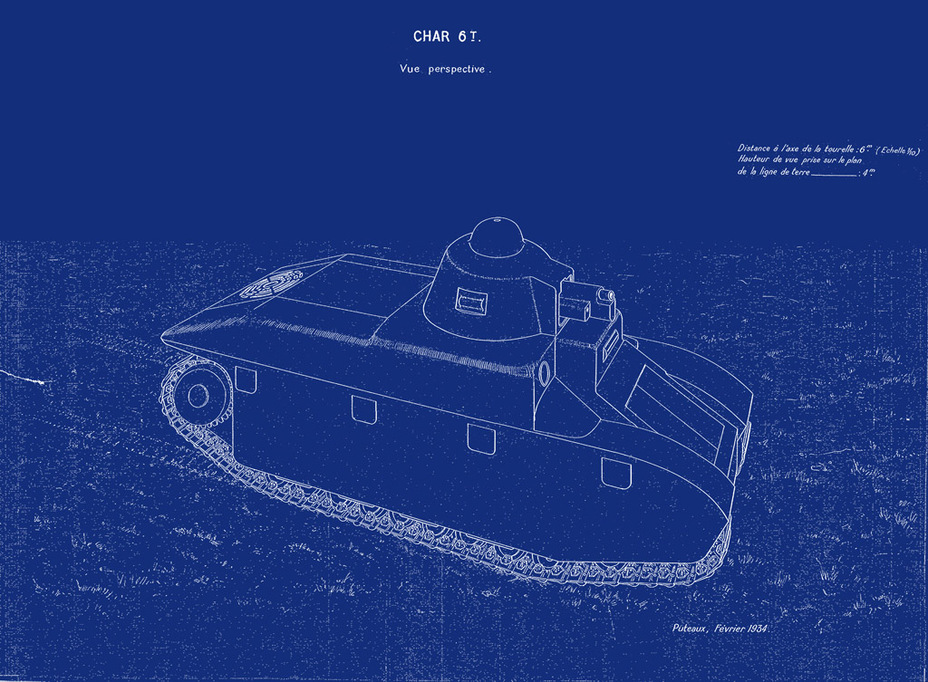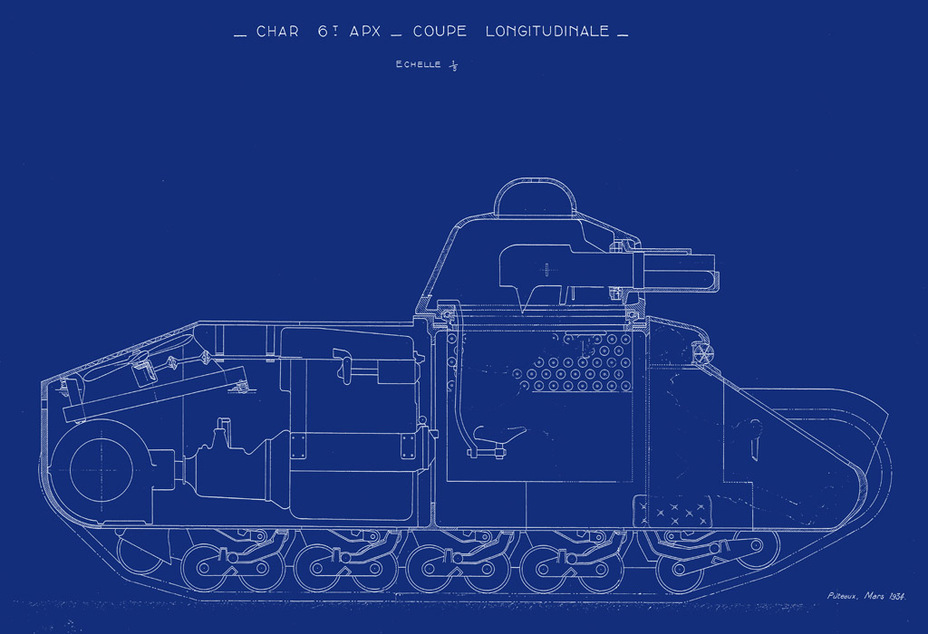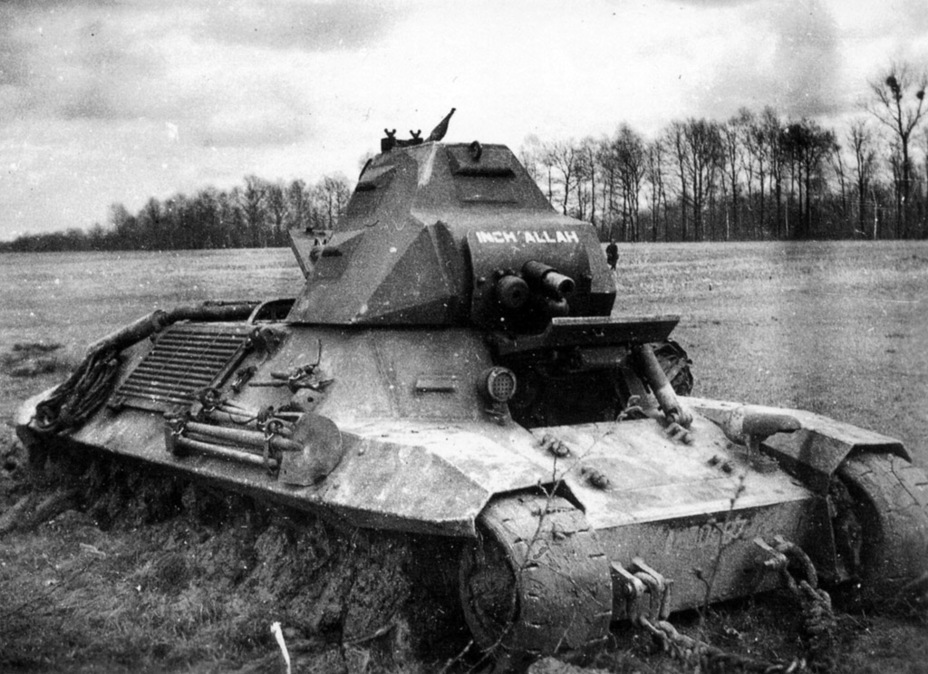The FCM 36 was the least lucky French tank created in the interbellum period. Its design was progressive: it was the first tank with sloped armour to be put into production. While other French tanks were put together with bolts or rivets, FCM made its hull welded. In addition, the FCM 36 had a diesel engine. Alas, the fate of this interesting tank was a difficult one.
Battle in the Rear Guard
The French army met the 1930s in a sticky situation. Nominally, France had the most tanks out of any nation in the world. In practice, the situation with tanks was worse than, say, with the Red Army in the summer of 1941. Almost all French tanks were obsolete. The backbone of the armoured forces was still made up of the Renault FT, the best tank in the world when it was made, but too slow and too poorly armoured by the 1930s. The French army needed a new tank: mass produceable, cheap, and well armoured.
The wishes of the army began to come true on August 2nd, 1933. On that day, requirements for a new light tank were drafted. According to specifications, this would be a 6 ton tank with no less than 30 mm of armour, a crew of two, a top speed of 8-10 kph, and armed with either two machineguns or one 37 mm gun. The initiator of these specifications was the Hotchkiss company, but 13 other companies bid for the tender. By early 1934, their number was reduced to 7. The first company to answer was Renault. Its Renault ZM design, later evolving into the Renault R35, was a clear favourite. As for the Hotchkiss company, which started this whole affair, it was satisfied with the building of a prototype, after which they suddenly reclassified the design into a cavalry tank. That's how the Hotchkiss H35 was born.
Meanwhile, the requirements for a light tank changed on May 22nd, 1934. Its armour was increased to 40 mm, the top speed was increased to 15-20 kph, and the machinegun variant was discarded. Four companies received funding to create a prototype: Delaunay Belleville, Compagnie générale de Construction de locomotives (Batignolles-Châtillon), Forges et Chantiers de la Méditerranée (FCM) and Renault. There was another company that reached the prototype stage: the tank branch of the artillery giant Ateliers de Puteaux (APX).

The first APX 6 ton tank project was dated February 1943. The tank was built with a wide use of cast parts. The small vehicle (4.4 m long with the tail, 1.58 m wide, 1.85 m tall) was propelled by a two-stroke 65 hp diesel engine. With a mass of 6.85 tons, the effective power was 9.5 hp/ton, which was decent for an infantry tank. The suspension included 11 road wheels per side. This maximized the contact area with the ground and promised a smooth ride. The suspension elements were protected with skirt armour.
As the August 2nd specifications dictated, its armour was 30 mm thick. There were two options for armament: a 37 mm SA 18 gun with a coaxial MAC Mle.1931 machinegun or two such machineguns. The armament was placed in a one-man turret which was not exceptionally roomy. However, as soon as April 18th, 1934, APX designers presented a new turret, indexed APX R (APX Rueil).

Sadly, no photographs of the Char 6-t APX remain. According to existing sources, a prototype was built by October of 1935. By then, there was no need for another light tank, especially one not built by the favoured list of companies. However, a completely different fate was in store for the turret. It was so well designed that it was selected for use on both the Renault R35 and Hotchkiss H35. APX could claim a partial victory in the competition. Even though its tank did not survive, it received a contract for making turrets.
Almost nothing is known about another participant in the contest, Delaunay Belleville. The famous producer of luxury cars from Saint-Denis did not even build a prototype of their light tank. It is not even known what their tank would look like. Instead, the company decided to focus on building a 1.5 ton truck for the army, but it was also unsuccessful in that enterprise.
The Batignolles-Châtillon company was more successful. The locomotive builders from Nantes reached the prototype stage in 1935. In April of that year, the tank was sent to trials. While their competitors used welding or casting, Batignolles-Châtillon were the only ones to make their hull with rivets. Cast armour was only used for the turret. The tank had several advantages: good vision (the designers were generous with observation devices) and sloped armour. The suspension with 7 road wheels paired into 3 bogeys with horizontal springs could potentially provide a smooth ride. In other words, the result was an adequate tank, no worse than its competitors.
Reliability was the Achilles' heel of the Batignolles-Châtillon light tank. During trials which lasted from April 5th to June 14th, 1935, the tank was pursued by technical issues. The suspension gave the most problems. Nevertheless, the French military liked the shape of the hull and turret, as well as the diesel engine. The tank was sent back for improvements, and re-entered trials in January of 1936. By then, the suspension was completely redone, not that it helped. Trials from January to August of 1936 revealed the same issues.
By then, the Renault R 35 was named the victor. Meanwhile, another tank, very similar to the Batignolles-Châtillon design, showed itself well.
Progressive, but Expensive
The Forges et Chantiers de la Méditerranée company had a rich experience in the field of tank building by the early 1930s. The company was responsible for the FCM 2C, the largest mass produced tank in the world, and was an active participant in the development of the Char B. A team led by engineer Bordeaux developed the suspension for the latter.
Bordeaux and his team started working on a light tank in early 1934. As required, the tank was designed for two variants: one with a 37 mm gun and one with two machineguns. The model of the tank, indexed Tracteur RN3, was built in the machinegun variant. After a demonstration of the model in March of 1934, permission for building a prototype was given. The prototype was ready by April of 1935, and was largely the same as the model, aside from the use of a 37 mm cannon.
At first glance, the influence from the Char B is obvious, especially in the suspension. Even the track links were similar. Bordeaux used 9 pairs of road wheels per side. Thanks to this solution, the tank moved smoothly across bumpy terrain. However, the suspension was just one of the progressive sides of the tank.
As with the Batignolles-Châtillon design, the tank's armour was sloped, but the plates were connected with welds instead of rivets. At the time, few tanks could boast fully welded hulls and turrets. Another part that separated the tank from its competitors was the engine. FCM chose a diesel engine for its tank. Initially, this was the 95 hp ACRO engine from the Berliet company, but it was too high maintenance and broke often. The second prototype used the 105 hp Ricardo engine from the same company.
The Tracteur RN3 prototype was shown to the approval commission on April 12th, 1935. The first trials did not go smoothly. Aside from engine trouble, the tracks had insufficient traction. While that could easily be corrected, the mass of the tank could not. It noticeably overtook the maximum acceptable limit of 10 tons. The commission also did not like the large air intake on the top of the hull. The tank was sent back to be corrected.
On September 10th, 1935, the second prototype entered trials, significantly changed compared to its predecessor. The shape of the turret changed, as well as the hull. The front part and rear were altered, and the driver's hatch was split into three pieces. Thanks to these changes, the hull was a little lighter. FCM engineers also changed the design of the track links, which were now equipped with grousers.
Trials continued until October 23rd, and demonstrated the progress compared to the first prototype. Nevertheless, there were complaints, mostly regarding the suspension. Even with grousers, the Char B type track links had poor traction. The front and rear mudguards quickly became jammed with mud. The idler and its mount also proved unsatisfactory.
The tank was sent back yet again, and returned on December 19th. The rear mudguards disappeared, and the front ones were noticeably reduced in size. The idlers and the mounts were changed. The tank was given new track links, much better than before. The gun was equipped with an external mantlet, which improved protection. During trials that lasted until May of 1936, the tank travelled 1372 km.
This time, the military was satisfied with everything but the armour. They demanded that its thickness should be increased to 40 mm. Since time was running out, the second prototype had 10 mm plates welded on. In this form, the Tracteur RN3 was presented to the approval commission on June 9th. The tank's fate was decided and on May 26th, 1935, FCM received an order for 100 Char léger Modèle 1936 FCM tanks.
Production of the FCM 36 ramped up slowly. The first batch of tanks were sent to the army only on May 2nd, 1938. The last tank arrived on March 13th, 1939. The tanks received registration numbers ranging from 30001 to 30100. The tank was not only the heaviest in its class, but also the most expensive. One FCM 36 cost 450,000 franks, while a Hotchkiss H 35 cost only 200,000. To compare, with that money you could buy one British Infantry Tank Mk.III, two Infantry Tanks Mk.I, or almost two German PzIIIs. Such was the price of the progressive design.
Regardless, infantry command was interested in this new tank. The turret was well liked, more so than the APX R turret on the Renault R35 and Hotchkiss H35. It was larger and the gun mantlet offered better protection. It was proposed that all light tanks would be equipped with the Tourelle FCM starting with turret #1351. Sadly, trials of the longer 37 mm SA 38 gun in the turret of tank #30057 showed that the turret welding seams began to crack after intensive fire. As a result, the idea was declined, even though the identical turret ring diameter would have made the replacement easy.
In 1938-39, FCM signed two mode contracts for 200 tanks in total. However, they were never produced: in the spring of 1939, FCM was reorganized to produce Char B1 Bis tanks. 72 of them were made in Toulon, which is about one fifth of all Char B tanks, which the military needed much more than light tanks.
Spearhead
The FCM 36 began arriving in military units in March of 1939. The first unit to receive these tanks was the 4th Battalion of Modern Light Tanks (Batallion de Chars Légers Modernes, BCLM or BCL for short), commanded by Major Saint-Cernin. In April, the 7th BCL was formed under the command of Major Jordani. Each battalion received 45 tanks.
Another 7 FCM 36s were used for training. The remaining 3 tanks were used for experimental work. For example, tank #30064 was used to test the effects of anti-tank mines. The mines proved effective enough that the tank was written off. It's worth mentioning that the French did not hide the new tank from prying eyes. On July 14th, 1939, tanks of the 7th BCL triumphantly drove across Avenue des Champs-Élysées.
On August 25th, 1940, BCLs were renamed to BCCs (Bataillons de Chars de Combat, tank battalions). By the start of WWII, the 4th BCC was included in the 502nd Tank Regiment, located at Angoulême, and the 7th BCC was a part of the 503rd Tank Regiment in Versailles. Both battalions were separated into three companies, which in turn were split into four platoons with three tanks each.
As other French tanks, the FCM 36 were generously decorated with various markings. For identification, playing card suits were used (blue for 1st company, white for 2nd, red for 3rd). The 3rd company of the 7th BCC was an exception, as it used two digit numbers for identification (31-33 for the first platoon, 51-53 for the second, 21-23 for the third, and 41-43 for the fourth). Several tanks received rapid identification markings in the form of a French flag on their turrets in spring of 1940. In addition, many tanks had emblems of the companies or proper names and personal symbols.
In late March of 1940, the 503rd Tank Regiment was moved to a training camp near Mourmelon for combined arms training. There, the regiment, along with the 7th BCC, met the May 10th German offensive. On the next day, the camp was bombed. On May 11th, the tanks were loaded on two echelons and sent to a camp near Vouziers in the Ardennes. The 4th BCC met the start of the offensive in Western France, in a camp near La Couronne. On May 10th, it was sent to Belgium.
By May 13th, the battalions ended up not too far from each other on the Franco-Belgian border. On that day, both units were subordinate to the 10th Army Corps. Interestingly enough, the 10th Army Corps already fought in WWI in these parts, and its actions were similar both times.
By then, General List's 12th Army crossed the Meuse river and attacked Sedan. The main strike force of the army were the 1st, 2nd, and 10th tank divisions. In the evening of May 13th, the units which included both FCM 36 battalions received orders to march north to Sedan.
The offensive began on the morning of May 14th. The tanks of the 7th BCC were the tip of the spear, and the tanks of the 4th BCC were to the east. The tankers were supported by the 205th and 213th infantry regiments. It's doubtful that the French knew that the 1st Tank Division under the command of Friedrich Kirchner was also beginning its attack. The 7th BCC met with the advance guard of the German tanks near Chémery. Initially, fortune favoured the French. The tanks of the 3rd company quickly dealt with an anti-tank gun and destroyed several light tanks and armoured cars on the approach to Bulson.
This is where their luck ran out. Behind the advance guard were the main forces of the German tank division, mostly consisting of medium PzIII tanks.
The result of that battle could have been different if the FCM 36 had long barrelled SA 38 guns. Alas, due to aforementioned problems, they were stuck with short SA 18 guns, inherited from the Renault FT. The gun was useless against tanks with more than 20 mm of armour. The 30 mm of armour on the PzIII proved impenetrable. One German tank was hit with 12 AP shells with little effect.
Quickly realizing what was happening, the Germans shot up the French tanks from point blank range. The armour, designed to protect against 25 mm autocannons, was insufficient. Interestingly enough, the PzIII are referred to as heavy tanks in reports of the 7th BCC.
To make things worse, German aircraft began pounding the positions of the 1st company of the 7th BCC, managing to hit not only French, but also German vehicles. 4 tanks from that company returned out of the 13 that went into battle. Some vehicles from the 1st company were shot up on the road to Chémery. The actions of the 7th BCC allowed the Germans to be delayed by a day. The cost of that delay was 29 out of 45 tanks. Most of the surviving vehicles had various degrees of damage.
As for the 4th BCC, it was covering the retreat of the 71st Infantry Division with assistance from the 205th Infantry Regiment. The German 10th Tank Division attacked in this direction, but no battles between it and the FCM 36 were recorded. The 4th battalion received orders to retreat to Stonne. Here, the battalion fought alongside the 67th Infantry Division in defense of the commune, taking heavy losses. Later, the 4th BCC was transferred to reserves and later fought for the Voncq commune on June 9th-10th, again taking heavy losses.

It is wrong to say that the FCM 36 did not prove itself. These tanks were no worse and no better than the Renault R35. Their effectiveness matched the technical requirements given for their development. Built for infantry support, the FCM 36 had to fight superior enemy armour. The courage of French tankers alone proved insufficient. By the end of the campaign, the French army only had 10 FCM 36 tanks left.
You can familiarize yourself with the last surviving FCM 36 from the Saumur tank museum here.
Translated by Peter Samsonov. Read more interesting tank articles on his blog Tank Archives.
Sources:
- Centre des archives de l'Armement et du personnel civil (CAAPC);
- FCM 36, Pascal Danjou, TRACKSTORY №7, 2007;
- GBM №81, №85, №106;
- http://cavaliers.blindes.free.fr/rgtdissous/bcc/bcc-h4.html;
- http://cavaliers.blindes.free.fr/rgtdissous/bcc/bcc-h7.html;
- http://www.chars-francais.net/2015/index.php/classement-individuel/fcm-36.






